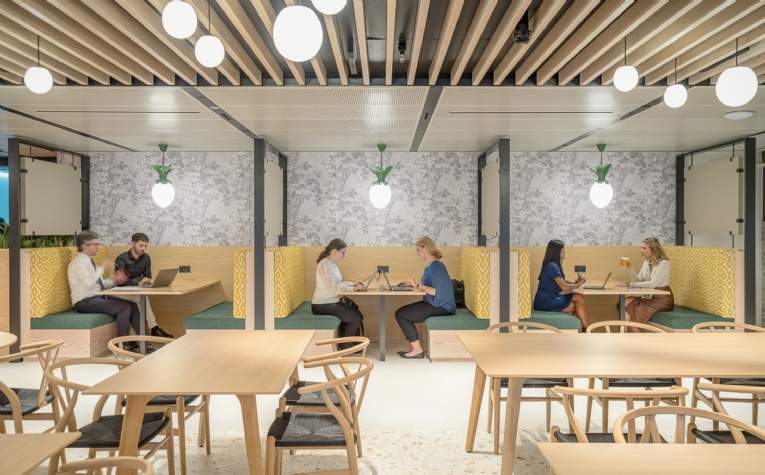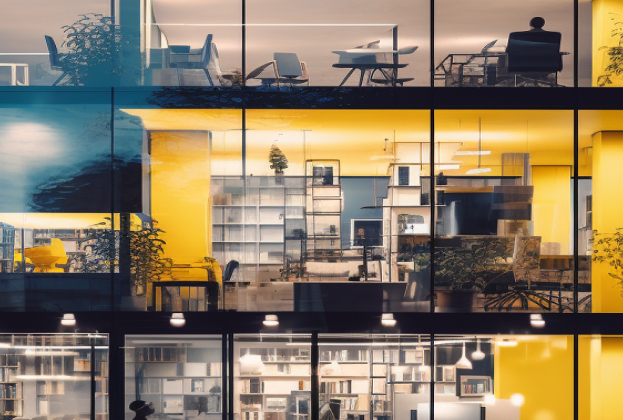The Legal Tenant
by Savills Workplace Studio
In the ever-changing workplace market, the legal industry is not immune to the need to adopt change and address the key challenges facing today’s legal firms. As the world continues to shift in where and how employees work, legal tenants are confronted with unique obstacles that require innovative workplace solutions. In this blog post, we delve into six significant challenges faced by legal firms with their workforce and workplace and explore potential strategies to overcome them.
Supporting seamless transitions between remote and in-person work modes
Post-pandemic, legal firms are still struggling to effectively adapt their in-person and remote work modes to create seamless meetings and workflow between one another. Hybrid professionals, those who work from the office and elsewhere, seek continuity and familiarity within their working environments. This issue can be solved in part, by rethinking meeting space with the appropriate room layout, shape, new technology, and furniture designs which provide a more inclusive and natural experience during hybrid meetings. As always, the goal is to maximize employee productivity and the firm’s success as teams continue to adapt to remote and in-person work modes.
Right-sizing client meeting spaces
As the pandemic has upended the traditional Monday to Friday, nine-to-five model, there has been a decline in in-person client meetings at the legal firms’ workplace – and thus, the need to right-size their meeting spaces. The trend away from on-site in-person client meetings has firms looking closely at and re-evaluating the number and types of meeting rooms dedicated to client-facing events. One proven successful way to do this is by tracking the number of meetings and adjusting; accordingly, for most firms this means reducing the size and quantity of event spaces.
Rebuilding adjacencies in a hybrid environment
Legal firms are faced with understanding the complexities of hybrid work in a way that does not diminish their profitability nor inhibits the firm’s culture. Legal firms are increasingly utilizing neighborhood approaches to design – to ensure that the efficiency of a hybrid model can be realized without practice groups losing their connection to each other and their business support teams. These approaches create a variety of seating options and increase flexibility by not assigning seats to individuals. Firms that take this approach are leveraging the latest booking technology, such as OfficeSpace, to ensure that individuals can find the team members they need when they visit the office.
Retaining and attracting top talent
When reimagining workplace strategies, legal firms’ essence still lies within their established corporate culture. By encouraging collaboration, mentorship, and inclusion, legal firms are not just retaining top talent, they are nurturing a sense of commitment and belonging for both clients and employees. Flexible work arrangements, dedication to work-life balance, and attention to personal and professional development are cornerstones of this cultural shift for the hybrid environment and, importantly, are attractive to new recruits.
Activating DEIA goals
Many legal firms have adopted rigorous frameworks to address Diversity, Equity, Inclusion and Accessibility (DEIA), and must now act to implement these changes throughout the workplace. An example is the creation of new spaces and adaptation of existing ones with neurodiversity at the center of the design. This includes not only updating accessibility standards but also rethinking noise levels, bright lighting, color, texture, and wayfinding. Legal firms are also enhancing inclusivity by introducing and incorporating elements that speak to how they support their local communities.
Aligning workplace design solutions with ESG goals, to enact cultural change
Aligning workplace design solutions with Environmental, Social and Governance (ESG) goals is essential for law firms to drive cultural change. Companies committed to ESG often strive to minimize their environmental footprints. This can translate into workplace design through the incorporation of low-impact materials, energy-efficient systems, and sustainable practices such as recycling and waste reduction. Incorporating flexible desking and workspaces, alongside spaces that promote DEIA fosters a more inclusive culture. Emphasizing workforce health and wellbeing through ergonomic furniture and green spaces enhances employee satisfaction. Employees at legal firms increasingly expect these positive impacts, and studies show that staff retention is closely linked to an organization's ESG performance, making these efforts crucial for long-term success.
Legal firms are addressing these six challenges in the workplace by changing how they allocate space to different activities, improving their technology offering, and rethinking the design of the space to be more inclusive, accessible, and efficient. Facing these challenges head on with unique and bespoke strategies enables legal firms to maximize their success while strengthening their culture, improving the lives of their workforce, and achieving their sustainability goals.
.jpg)
.jpg)
.jpg)

.jpg)
.jpg)
.jpg)



